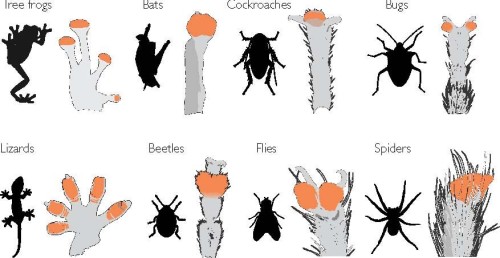
Stick together: both ants and geckos have adhesive pads that let them scale vertical surfaces. (Courtesy: A Hackmann/D Labonte)
By Tushna Commissariat
Don’t tell the kids just yet, but becoming Spider-Man, even after being bitten by a radioactive spider, is looking less and less likely for us humans – we are just too big. The latest work, done by researchers at the University of Cambridge in the UK, has shown that gecko-sized is pretty much the largest you can be if you realistically want to scale up walls with adhesive pads. Any bigger, and most of your surface area would need to be covered in large sticky pads to pull off the gravity-defying walk. Indeed, the team estimates that roughly 40% of an average human being’s total body surface would need to be sticky – this means a whopping 80% of your front would be covered in adhesive pads.
In the study, recently published in the journal PNAS, the Cambridge researchers show that for most climbing creatures – extending from flies to spiders to tree-frogs and geckos – the amount of their body surface that needs to be adhesive increases as body size increases, thereby setting a limit on the size of animal that can use this method without having disproportionately large feet. David Labonte and colleagues in the University of Cambridge’s Department of Zoology found that geckos are nature’s largest adhesion-based climbers.
Once an animal is big enough to need a substantial fraction of its body surface to be covered in sticky footpads, the necessary morphological changes would make the evolution of this trait impractical, suggests Labonte. “As animals increase in size, the amount of body surface area per volume decreases – an ant has a lot of surface area and very little volume, and a blue whale is mostly volume with not much surface area,” he explains. Most larger climbing animals have evolved other climbing techniques such as claws and toes to help with their grip.
The team compared the weight and footpad size of 225 climbing animal species including insects, frogs, spiders, lizards and even a mammal. They compared animals covering more than seven orders of magnitude in weight, “which is roughly the same as comparing a cockroach with the weight of Big Ben, for example”, says Labonte. All of the work points to one conclusion – that following in the sticky footprints of a gecko would be impossible for a human unless they had European size 145 feet!

Scaling up: the diversity of sticky footpads. (Courtesy: David Labonte)
Despite all of this, if you are determined to be gecko-like and scale a wall, there may be a last option – to make your sticky footpads even stickier. “We noticed that within closely related species, pad size was not increasing fast enough to match body size, probably as a result of evolutionary constraints. Yet these animals can still stick to walls,” says Christofer Clemente of the University of the Sunshine Coast in Queensland, Australia. “Within frogs, we found that they have switched to this second option of making pads stickier rather than bigger. It’s remarkable that we see two different evolutionary solutions to the problem of getting big and sticking to walls.”
The gecko and its climbing abilities has long fascinated physicists – you can read our stories about a geckos’ electric grip, a “gecko tape” and even a nanotube-based Spider-Man suit. Labonte and team hope that their work will have implications for artificial bio-inspired adhesive materials, which are currently only effective on very small areas.
Trackback: Scientists officially ground Spider-Man – MyPhysNet